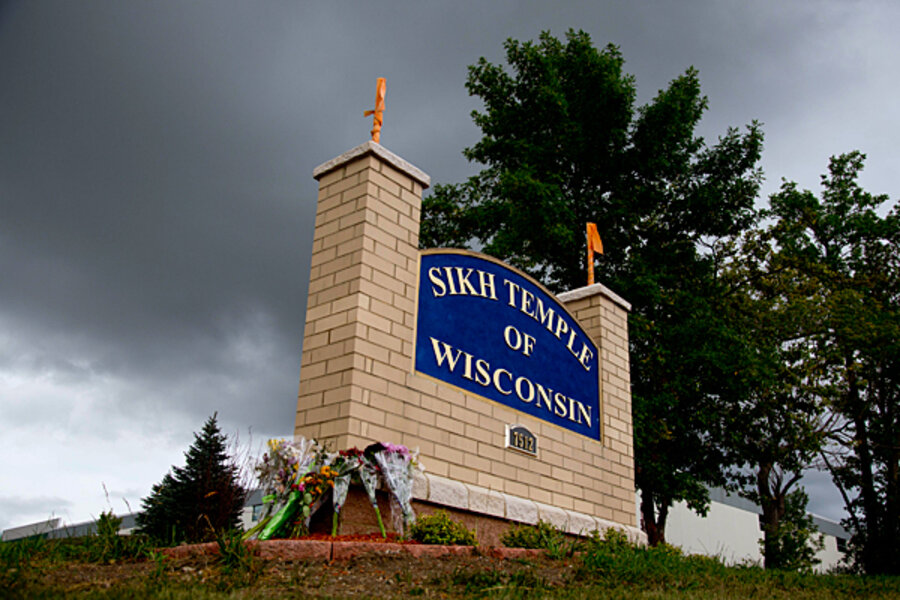In Sikh temple shooting, signs of a changed white supremacist movement
Loading...
| Chicago
The Sunday shooting that killed six people at a Sikh temple outside Milwaukee was denounced by some perhaps unlikely entities – several national white-supremacist organizations, the record label that produced several recordings by the shooter’s racist punk band, and even his ex-girlfriend, who law enforcement officials say was active with at least one such group prior to the shooting.
The remorse is not unexpected, since Wade Michael Page, who shot himself, probably acted alone and without directive from any single group, the Federal Bureau of Investigation says. His profile reflects the changing face of the white-supremacist movement, from an earlier era dominated by a few monolithic and hierarchical organizations like the Ku Klux Klan, to today, which is represented by hundreds of area splinter groups that are largely leaderless and unconnected to one another.
Over the past two decades, violent acts attributed to hate have been largely connected to single individuals, or “lone wolves,” analysis has shown. As the Internet has gained ascendancy, the public rallies, marches, and mass recruitment efforts associated with hate groups have largely become a thing of the past.
Today, smaller cells can operate more freely, without detection.
“The groups are really, really small; we’re talking about tiny groups of people. But they’re a very dangerous group of people,” says Kathleen Blee, a sociologist at the University of Pittsburgh and author of “Inside Organized Racism: Women in the Hate Movement.”
The number of hate groups has increased 69 percent since 2000, following decades of relative quiet or inactivity, according to the Southern Poverty Law Center. Today, 1,018 such groups are operating, a historic high. These groups include neo-Nazis, white nationalists, Klan organizations, skinheads, black separatists, and border vigilante groups.
Immigration and the election of Barack Obama are two key factors that explain why groups are multiplying. But the catalyst in making them flourish is the advent of social media, which has enabled like-minded people to connect with others in their area. For example, the FBI said, both Mr. Page and his ex-girlfriend Misty Cook frequently posted to Stormfront, the largest social-network site for white nationalists, which allows users to discuss anything from politics and social philosophy to music and even dating.
“The Internet has enabled social networks to usurp the monopoly that hate groups previously had. If you wanted to belong to that subculture, you had to be tied to that group. Now, you can create your own group,” says Brian Levin, director of the Center for the Study of Hate and Extremism at California State University, San Bernardino. “Just like how all politics are local, much hate is local, particularly for young people.”
Because members of the Millennial generation have become increasingly tolerant compared with generations past, Mr. Levin says, “those who are left are the ones who have significant issues” – such as social isolation, substance abuse, difficulties with women, or domestic abuse. This increases the potential for sporadic violence.
He compares the phenomenon to the jihadist movement, where single individuals who take it upon themselves to strike are largely responsible for the acts of violence.
“Technology has allowed an otherwise splintered, disjointed leadership movement to coalesce around personal anger,” Levin says.
Ms. Blee says white-supremacist groups are no longer “trying to win over the hearts and minds of millions of people,” instead adopting a smaller nature.
“They don’t recruit anymore from the mainstream. They’re deliberately smaller,” she says. “These small, dedicated units are much more important [to the white-supremacy goal] than a big group of people that you really can’t control.”
While larger organizations say on their websites that they do not condone violence, the political rhetoric and fervor they generate has often factored into the actions of lone wolves.
These include Richard Poplawski, who killed three police officers outside Pittsburgh in 2009 after espousing racist views on Stormfront; and Benjamin Smith, who went on a shooting spree in Illinois and Indiana in 1999, which killed two people. Mr. Smith had a history of passing out hate literature on college campuses and in Wilmette, Ill., his hometown.
Even though lone wolves don’t receive direct orders, their actions follow the concept of “leaderless resistance” promoted by famed Texas white supremacist Louis Beam, Levin says. The movement’s future, Mr. Beam said, depends on personal actions by individuals because the larger organizations are too prone to corruption and infiltration.
“Hate groups still play a role, but from an operational standpoint, they certainly do not have ownership over the total pool of domestic extremists,” Levin says. “They have influence over them, to be sure, but they don’t direct them.”








